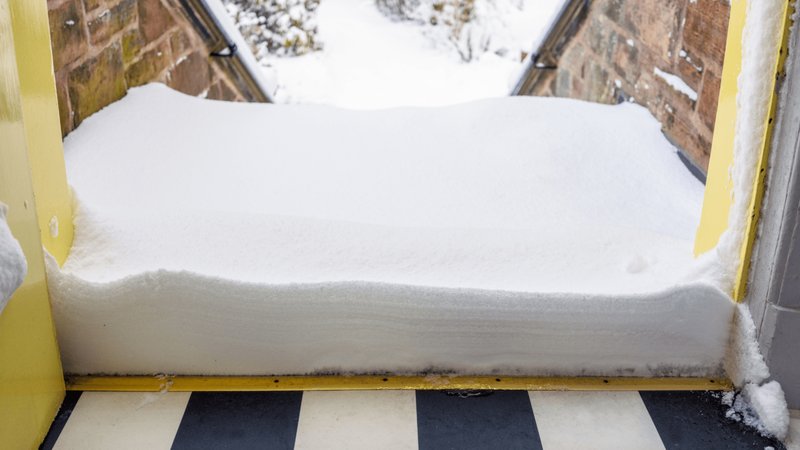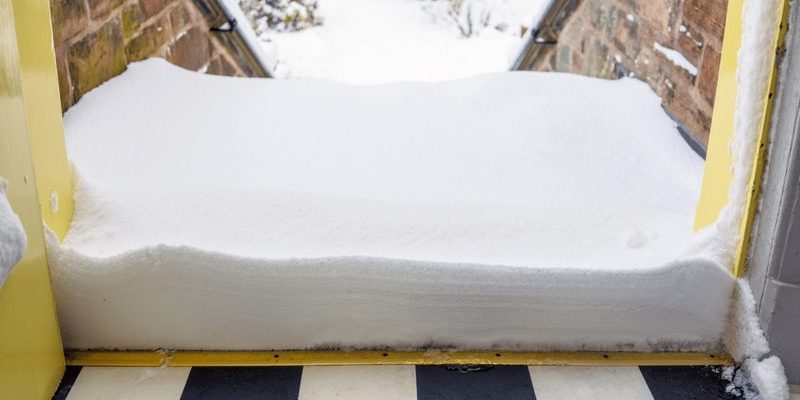
Here’s the thing: frozen thresholds aren’t just an inconvenience—they can actually damage your door, wear down weather stripping, or let in drafts that hike up your heat bill. Some doors are more vulnerable than others, too. For example, older wooden entries or builder-grade metal doors—like some of the basic Stanley or Masonite brands—can be especially finicky when ice gets involved. Whether it’s your back entry, a garage door, or a side utility door that’s giving you grief, let’s break down why this happens and, more importantly, how you can fix it for good.
Why Does the Door Threshold Freeze in the First Place?
If you’re scratching your head about how a door can get frozen shut, you’re not alone. The most common reason is a mix of moisture and cold air—nature’s version of glue. Water from rain, melting snow, or even just condensation can seep into the tiny gap where your door meets the threshold. When temperatures plunge, that moisture freezes, sticking the two surfaces together.
Honestly, even the best-installed doors have tiny imperfections. Over time, weather stripping compresses, and wood or metal can warp ever so slightly. Sometimes, doors swell a bit after a wet day, and even a millimeter of difference creates the perfect spot for water to sneak in. It doesn’t help if you have a drafty entryway or the snow piles up right outside the door—both increase the risk of freezing shut.
The problem can be worse if you have older or cheaper thresholds. Some brands, especially those with thin aluminum strips or low-profile vinyl sills, don’t insulate well. They can get icy faster than beefier wooden or composite options. And if your threshold’s screws are loose or it’s sagging, you’re basically inviting water inside. So, it’s not just the weather—it’s about how your door and the threshold are built and maintained.
Signs Your Threshold Is Freezing to the Door
At first, you might just notice your door is harder to open—a little more resistance, maybe a creak or a groan. But a truly frozen threshold puts up a real fight. Sometimes, it’ll even sound like Velcro tearing when you finally manage to wrestle the door open.
Look for these clues:
- Visible ice or frost along the bottom edge of the door or across the threshold. Even a thin, clear glaze can freeze things solid.
- Stuck or warped weather stripping that pulls away or feels crunchy. This means water seeped in and froze, pushing the strip out of place.
- Shiny wet spots after you get the door open. This is leftover melted ice.
- Repeated sticking in the same spot, especially after cold nights or snowstorms.
You might be tempted to just yank harder, but that risks bending the metal, shredding the bottom seal, or even cracking the door panel (especially if it’s wood or composite). Instead, recognizing these early warning signs gives you a chance to tackle the problem before it gets bigger—or at least avoid a morning hand injury.
How to Safely Unstick a Frozen Door Threshold
When your threshold is frozen to the door, patience pays off. Don’t go straight for brute force—that’s a recipe for repairs. Here’s what works:
- Check for gaps: Sometimes, just a gentle nudge upward or sideways can free the seal without damage. Try lifting the handle slightly as you press the door.
- Use warm (not boiling) water: Pour a little over the threshold, focusing where you see ice. Dry up the excess right away to avoid more freezing.
- Plug in a hair dryer: Set it on low and sweep the heat across the bottom edge. This melts ice without warping the door or frying the electronics if you have a keypad.
- Don’t use metal tools: Avoid chisels or flathead screwdrivers. One slip and you’ll gouge the wood or scratch the paint—trust me, it’s not worth it.
Let me explain: sometimes the best “troubleshooting” is just staying calm. If you have a garage entry that’s stuck, use another entrance if you can, and give the frozen door a few minutes to thaw naturally with heat or warm water. If it’s truly urgent, gentle is always better than aggressive.
Expert Tip: Never pour boiling water on a frozen threshold. Sudden temperature swings can crack vinyl, warp wood, or even shatter glass inserts.
Preventing Threshold Freezing: Tips That Actually Work
Once you’ve wrestled your door open, you don’t want to repeat the same battle tomorrow. The real secret to troubleshooting a threshold that freezes to the door in winter is prevention. Here’s what makes a difference:
- Apply a silicone-based lubricant or spray to the threshold. Don’t use cooking spray or oil—they attract dirt and break down seals.
- Use weatherproof door sweeps or double-check your weather stripping. Cracks, gaps, or wear give water easy access to freeze.
- Shovel and clear away snow immediately after storms. Even if you’re tired, making a small path lets the area dry before nightfall.
- Switch to a higher-quality threshold if you have the budget. Composite or heavy-duty aluminum models resist freezing better than thin vinyl strips and are easier to sync or pair with modern entry doors.
A little prevention goes a long way. Even a modest, regular code of maintenance—like a monthly wipe-down and lubricant—can reset your door’s resistance to freezing.
When to Adjust or Replace Your Threshold
Sometimes, troubleshooting just isn’t enough. If you’re fighting the same frozen threshold every winter, it may be time for an upgrade. Here’s how to know when you’re due for a change:
- Threshold sags or feels loose. This lets water in, and no amount of quick resets or code adjustments will fix the underlying issue.
- Weather stripping is flattened or missing. You can try DIY replacement kits, but if the base is creased or deformed, replacing the whole threshold works better in the long run.
- Visible rust, warping, or rot. Wood thresholds that look punky or spongy are past their prime. Metal ones with bubbling paint or flaking are letting water underneath—retiring them is the way forward.
Most standard door brands, from Stanley to Masonite, sell easy-to-install replacements. You can usually pair a new threshold with your existing door using simple hand tools. It’s a weekend project that pays off all winter.
Weatherstripping Upgrades: A Smart Solution
The right weatherstripping can make or break your door’s ability to resist freezing. Today’s options aren’t just those old-school felt strips that peel away; you can sync your setup with heavy-duty silicone, magnetic seals, or snap-in vinyl.
Here’s how to pick the right one:
- Silicone: Flexible, durable, and doesn’t get brittle in the cold. Great for repeated freeze-thaw cycles.
- Magnetic strips: Excellent for steel doors—just make sure they line up perfectly to form a tight seal.
- Vinyl sweeps: Easy to install but can get stiff in extreme cold. Reset them mid-season if you notice gaps.
If you’re unsure, check your door’s brand for compatibility—universal kits fit most entry doors, but OEM alternatives give a more custom fit. Don’t be afraid to ask for help at the hardware store. A $10 upgrade can save you countless mornings of frozen frustration.
Comparing Quick Fixes vs. Long-Term Solutions
You might be wondering if there’s a shortcut to all this—something you can do in a minute instead of overhauling your threshold. Here’s a quick table that compares the most common quick fixes with real, lasting solutions:
| Quick Fix | Long-Term Solution |
| Warm water to melt ice | Install higher-quality threshold |
| Hair dryer to unfreeze | Upgrade weatherstripping |
| WD-40 or temporary lubricants | Seal exterior doorframe and maintain monthly |
| Towel under the door | Re-level and re-pair door/sill assembly |
Honestly, band-aid fixes are fine when you’re in a rush, but investing a little time in a stronger threshold or better seal pays you back with every worry-free winter.
When to Call a Professional for Threshold Problems
Some situations call for expert troubleshooting. If you’ve tried everything—reseating the threshold, pairing better weatherstripping, and even resetting your door alignment—but the problem keeps repeating, it’s time to call in a pro. They have tools and tricks that go beyond what’s in most people’s garages.
A professional can spot:
- Hidden rot or mold in the sill or subfloor area.
- Advanced warping that requires a full door code or frame reset.
- Issues with the door’s original installation—sometimes, even the best DIY troubleshooting won’t cut it.
Think of it like this: when your remote stops syncing with your garage, sometimes you just need fresh batteries; other times, the whole receiver is at fault. With frozen thresholds, don’t hesitate to ask for help if you’re stuck—literally or figuratively.
Pro Insight: Many big box stores offer installation services with warranties, so if your threshold keeps freezing, a professional install means peace of mind (and warm toes).
Closing Thoughts: Staying Ahead of Frozen Thresholds in Winter
Dealing with a threshold that freezes to the door in winter is a hassle no one wants—but it’s definitely fixable. Most of the time, it’s a mix of old weatherstripping, sneaky moisture, and just plain cold air. The good news? With a few basic troubleshooting steps, you can reset your entryway for the season and avoid those chilly wrestling matches at your front door.
Remember, whether you own a basic builder-grade door or a fancier brand, prevention is key. Upgrading your threshold, syncing up new weatherstripping, or just keeping that area dry and clear can save you a lot of effort. And if you ever feel out of your depth, it’s okay to call in a pro. Stay warm, stay safe, and may your doors open smoothly all winter long.
